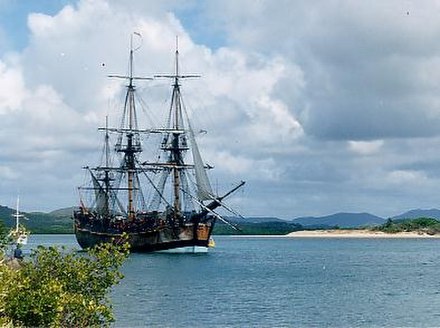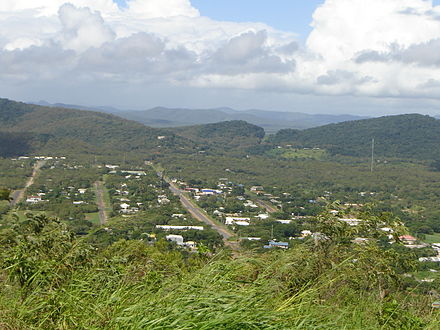Cooktown - town in Queensland, Australia
Cooktown is a small coastal town in tropical north Queensland. In 1770 Captain James Cook landed on the banks of the Endeavour River repairing his ship Endeavour, after it ran aground on the Great Barrier Reef. A century later, in 1873, it became the port for the Palmer River Goldfields. Today it is billed as the gateway to the wilderness. It offers Mountains, Outback terrain, as well as some of the top scuba diving around. Although it still has well developed facilities, the town has more of a frontier feel, as is vastly different to the resort towns further south along the coast.
Understand

History
The first European visit to Cooktown took place when Captain Cook holed his ship on a reef just south of Cooktown, and beached his ship at the mouth of the Endeavour River to undertake repairs. He spent 48 days here, from 17 June to 4 August 1770. Over 100 years later, Cooktown became one of the main gateways into Australia with the gold rush to the Palmer River. Grand permanent buildings were established, and the population boomed. A railway was even constructed from Cooktown to the goldfields.
With the passing of the goldrush days, and a decline in shipping, Cooktown went into decline. The town was frequently cut off by flooding in the wet, and the gravel road to Cooktown was washed out frequently. Cooktown became a victim of its isolation.
The visit of the Queen Elizabeth II to Cooktown in 1970 still rates highly in the history of the town.
The sealed road made it to Cooktown in the 1990s, bringing with it a small resurgence in the fortunes of the town, with the arrival of tourism. The town's population has never recovered to the level of the goldrush days, but today is slowly increasing.
The place is called Gungardie in the language of the Guugu Yimithirr, and has had a continuous occupation by indigenous Australians stretching back thousands of years.
Geography
 The town itself is on the banks of the Endeavour River estuary, although only a few kilometres overland from the ocean.
The town itself is on the banks of the Endeavour River estuary, although only a few kilometres overland from the ocean.
There is an amazing natural environment that surrounds the area. From the Great Barrier Reef to the rainforests of the World Heritage Wet Tropics and the savannahs of Cape York. Cooktown is a great base to explore these renowned areas.
Climate
Cooktown is well inside the tropics, experiences the seasonal monsoon in summer, and in general has warm and dry winters. There are a couple of weeks a year in winter when the weather can get cooler and rain is more common, usually around the beginning of July. The locals will tell you that Cooktown has a couple of weeks of winter a year.
Get in
Cairns is probably the main access point for Cooktown, with an international airport, and good bus and train connections around Australia. Most people arrive in Cooktown by car or camper.
By car
Cooktown is just over 300 km north by road, from Cairns. The drive to Cooktown from Cairns is easy. The trip takes around 3 hours, is well signposted and hard to get lost. The driving challenges begin north of here.
There is an unsealed dry-weather road that cuts through the Daintree National Park following the coast. It offers better scenery, but not usually a quicker trip. Rental cars are not usually permitted on this road.
Cooktown is just over 2000 km from Brisbane.
By air
Hinterland Aviation offer a regular service from Cairns to Cooktown with flights 3 times a day Monday to Friday and a Saturday morning flight.
By bus
Country Road Coachlines travel by both the coastal and inland routes, connecting Cairns and Cooktown three times a week. The coastal service also stops in Port Douglas and the inland service in Kuranda.
Get around
The township itself is easily traversed by foot, and there are a few interesting walks to the national park and beaches that start right at the edge of town. There is a taxi service in town, and an airport shuttle.
See

- Discovery Festival. Every June (on the June long weekend) Cooktown celebrates Cook's landing with a re-enactment.
- James Cook Museum, Cnr Helen & Furneaux St, -15.4689°, 145.2506°, +61 7 4069 5386, jamescookmuseum@nationaltrustqld.org. Daily 9AM-4PM from 1 May to 30 September except during public holidays and extreme weather events. Documents Cook's voyages, Aboriginal and natural history, the gold rush and the legacy of the Chinese miners. The museum is housed in a former convent school that was built in 1888 and run by Irish nuns. Adults $15, children $5, concession $10, families $35
- Bank Museum is run by the local historical society, and is a well presented history of the town.
- Grassy Hill. Close to town, provides a view little changed from that Captain Cook could have seen. The sunsets from Grassy Hill are renowned.
- Remains of blacksmith shop and Chinese well (Turn off Bichtumen onto Oakey Creek Rd about 20 km along) at the oldest mango trees in Australia.
- The concrete steps by the side of the river in the park were built for the arrival of the Queen in 1970, she disembarked there during her short but resounding visit to Cooktown.
Mount Cook National Park redirects here. For the park in New Zealand, see Aoraki / Mount Cook National Park
- Mount Cook National Park, -15.492778°, 145.259167°. A Queensland national park with lookouts and walking trails. 2022-03-01
Do

- Scenic Rim Walk
- Cemetery Walk - there is a walk that starts from behind the old train station, and goes along the mangroves to the Cemetery. There are several historic graves to see.
- Botanic Gardens and large bush area, with a discovery visitors centre in the middle of the park. Highlight is probably the bushwalk over to Cherry Tree Bay that forms part of the Scenic Rim Walk.
- Cooktown river cruise sets off daily from the wharf up the Endeavour River. Expect to see a croc or two, large varieties of mangroves, birdlife, and maybe a snake.
- Musical Playground has xylophones, pipes, sails and drums. Fun for kids and adults alike, in the park next to the river.
Buy
- The Croc Shop is the souvenir destination. It is also possible to view and purchase Aboriginal art.
- Cooktown is a base for supplies, and you should have no problem finding most things at the supermarkets in town.
Eat
Expect to pay a premium over Cairns to eat out in Cooktown. There is a take-away/bakery at the southern end of town, which probably offers the best value, but closes early evening. If you don't take care of dinner early, you could be left with very few budget alternatives.
- Jackey Jackey Thai, 152 Charlotte St, -15.46412°, 145.25038°, +61 7 4069 5951. Jackey Jackey was an historic building that used to be the general store. Now a Thai restaurant. 2018-07-03
The pubs and clubs serve traditional pub and club fare. Expect to pay around $20+ for mains at these places.
Many of the hotels have restaurants, and there is a pizza place as well.
Drink
There are two clubs, and three pubs in Cooktown, all are located along the main strip, and you won't have any problem finding them. The Bowls Club and the RSL Club both have a similar feel, not much to tell them apart really. The Cooktown Hotel, known only as the Top Pub is the most visitor friendly. In days past the pubs had distinct clientele, but these days you should feel comfortable having a beer wherever you choose.
- Cooktown Hotel (The Top Pub). Meals 7 days, and accommodation.
Sleep
- Milkwood Lodge. Six pole cabins, swimming pool on the road into Cooktown.
- Sovereign Resort Hotel, 128 Charlotte St, -15.46611°, 145.2505°, +61 7 4043 0500, info@sovereignresort.com.au. 2 bedroom apartments and studios. A central pool and small tropical garden. Fronts straight onto the main strip. Nice view across to water from the restaurant and balcony upstairs, worth going up there for a coffee. from $174 2018-07-03
Stay safe
If you look at brochures for Cooktown from the 1990s they will advertise beaches and swimming as features of the town, but all those references have been removed from any recently produced documentation. Finch Bay and Cherry Tree Bay both have nice beaches, and you can drive to Finch Bay, and walk to Cherry Tree Bay. Crocodiles have been sighted at times on both beaches, and marine stingers are present during the season.
Crocodiles and stingers also inhabit the creeks. Take care when bushwalking during the wet. If the creeks are up over the track, don't cross them.
Go next
Take Oakey Creek Rd and follow the road to the oldest mango trees in Australia, planted between Oakey Creek and Lions Creek. Over 30 trees in a line along the road that is about 20 km off bitumen. Amazing!
To continue further north than Laura requires planning. Its possible to go into the Cape Melville National Park along tracks, with a 4wd, or return to the Peninsula Developmental Road at Lakefield, to continue north to Weipa. The road is sealed and unsealed, but should be accessible to 2wd vehicles. Its essential to check road conditions, and to accept that roads can be closed quickly due to rising water at creek crossings.
At Cooktown you are still 900 km from the top of Australia at Cape York.